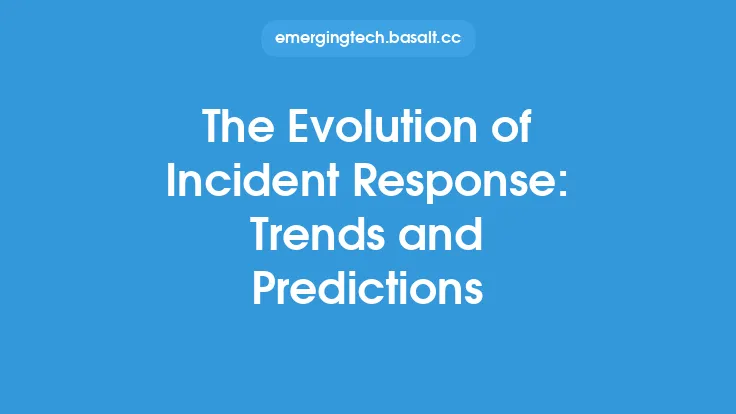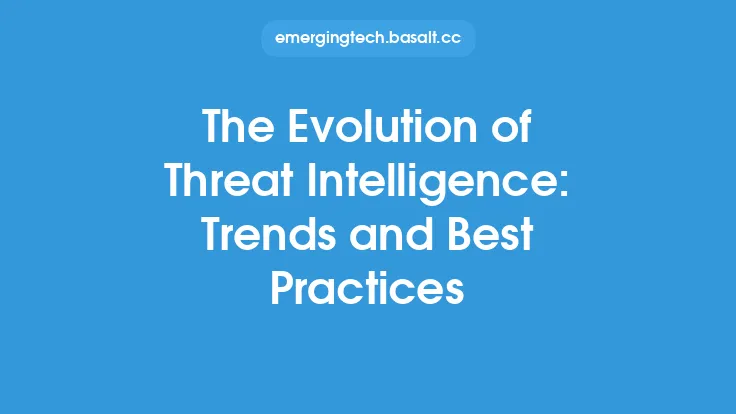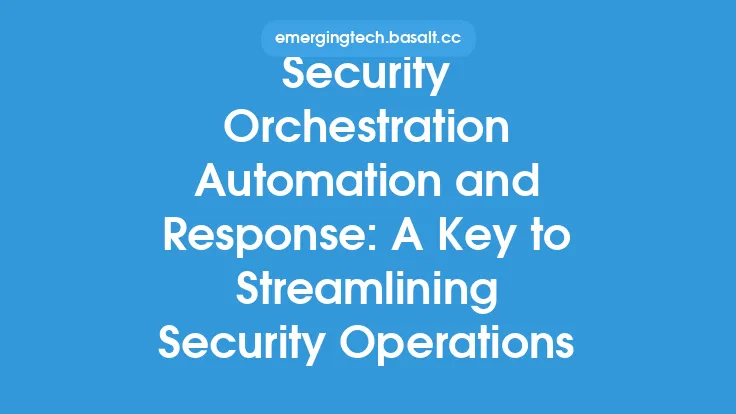The security landscape has undergone significant transformations over the years, with the increasing complexity and frequency of cyber threats pushing organizations to rethink their security strategies. One key area that has seen substantial evolution is Security Orchestration Automation and Response (SOAR), which has become a crucial component of modern cybersecurity operations. In this article, we will delve into the trends and insights shaping the evolution of SOAR, exploring its history, current state, and future directions.
History of SOAR
The concept of SOAR has its roots in the early 2000s, when security information and event management (SIEM) systems began to emerge. These systems were designed to collect and analyze log data from various security sources, providing a centralized view of an organization's security posture. However, as the volume and complexity of security data grew, it became clear that manual analysis and response were no longer sufficient. This led to the development of security orchestration, which aimed to automate and streamline security processes using workflows and playbooks. The introduction of automation and response capabilities marked the beginning of the SOAR era, as organizations sought to integrate people, processes, and technology to improve their security operations.
Current State of SOAR
Today, SOAR has become a vital component of cybersecurity operations, enabling organizations to respond quickly and effectively to an ever-increasing number of threats. Modern SOAR solutions integrate with a wide range of security tools and systems, including SIEM, threat intelligence platforms, and incident response tools. These solutions provide a centralized platform for security teams to manage and respond to security incidents, leveraging automation and orchestration to streamline processes and reduce manual effort. The current state of SOAR is characterized by a focus on integration, automation, and analytics, with organizations seeking to leverage these capabilities to improve their security posture and reduce the risk of breaches.
Trends in SOAR
Several trends are shaping the evolution of SOAR, including the increasing adoption of cloud-based solutions, the growing importance of artificial intelligence (AI) and machine learning (ML), and the need for greater integration with other security tools and systems. Cloud-based SOAR solutions offer greater scalability and flexibility, enabling organizations to quickly deploy and manage their security operations. The use of AI and ML is also becoming more prevalent, as these technologies can help automate and improve the accuracy of security incident response. Furthermore, the need for greater integration is driving the development of more open and extensible SOAR platforms, which can seamlessly integrate with a wide range of security tools and systems.
Technical Advances in SOAR
From a technical perspective, SOAR solutions are leveraging a range of advances in areas such as automation, orchestration, and analytics. Automation is being driven by the use of robotic process automation (RPA) and scripting tools, which enable security teams to automate repetitive and mundane tasks. Orchestration is being facilitated by the use of workflow management systems and playbooks, which provide a structured approach to security incident response. Analytics is also playing a critical role, with the use of data analytics and visualization tools helping security teams to identify and respond to security threats more effectively. Additionally, the use of application programming interfaces (APIs) and software development kits (SDKs) is enabling greater integration between SOAR solutions and other security tools and systems.
Insights from the Field
Insights from the field highlight the importance of SOAR in modern cybersecurity operations. Security teams are leveraging SOAR to improve their response to security incidents, reduce manual effort, and enhance their overall security posture. The use of SOAR is also enabling organizations to better manage their security operations, providing a centralized platform for security teams to collaborate and respond to security threats. Furthermore, the integration of SOAR with other security tools and systems is helping to break down silos and improve communication between different security teams. As one security professional noted, "SOAR has been a game-changer for our organization, enabling us to respond more quickly and effectively to security incidents and improve our overall security posture."
Future Directions
Looking ahead, the future of SOAR is likely to be shaped by a range of factors, including the increasing use of AI and ML, the growing importance of cloud-based solutions, and the need for greater integration with other security tools and systems. As SOAR solutions continue to evolve, we can expect to see greater use of automation and orchestration, as well as more advanced analytics and visualization capabilities. The use of SOAR is also likely to expand beyond traditional security teams, with other business functions such as IT and compliance leveraging these solutions to improve their security operations. Ultimately, the future of SOAR will be characterized by a continued focus on integration, automation, and analytics, as organizations seek to leverage these capabilities to improve their security posture and reduce the risk of breaches.
Conclusion
In conclusion, the evolution of SOAR has been shaped by a range of factors, including the increasing complexity and frequency of cyber threats, the growing importance of automation and orchestration, and the need for greater integration with other security tools and systems. As SOAR solutions continue to evolve, we can expect to see greater use of AI and ML, more advanced analytics and visualization capabilities, and a continued focus on integration, automation, and analytics. By understanding the trends and insights shaping the evolution of SOAR, organizations can better leverage these solutions to improve their security operations and reduce the risk of breaches. Whether you are a security professional, a business leader, or simply someone interested in cybersecurity, it is clear that SOAR will play a critical role in shaping the future of cybersecurity operations.





